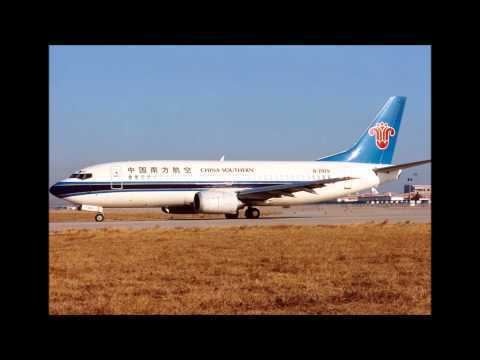Passengers 65 Fatalities 35 Date 8 May 1997 Injuries (nonfatal) 9 Location Shenzhen | Crew 9 Survivors 39 Number of deaths 35 | |
 | ||
Destination Shenzhen Bao'an International Airport Similar Air China Flight 129, China Airlines Flight 140, China Southern Airlines Fl, Vietnam Airlines Flight 815, Korean Air Flight 801 | ||
China Southern Airlines Flight 3456 (CZ3456/CSN3456) was a scheduled domestic passenger flight from Chongqing to Shenzhen Huangtian Airport (now Shenzhen Bao'an International Airport), Guangdong, China. On May 8, 1997, the Boeing 737 performing this route crashed during the second attempt to land in a thunderstorm. The flight number 3456 is still used by China Southern for the Chongqing-Shenzhen route but with Airbus A320 family aircraft.
Contents
Aircraft
The aircraft was delivered to China Southern on February 2, 1994, and had recorded over 8,457 hours before the crash.
Flight crew
The captain of Flight 3456 was 36-year-old Yougui Lin (Chinese: 林友贵), at the time of the crash, he had logged 12,738 hours of total flying time, of which 9,084 hours as radio operator, 3,654 as pilot. The first officer, Dexin Kong (Chinese: 孔德新), 45, had 15,537 hours of total flying time, including 11,203 hours as flight engineer, 4,334 as pilot.
Weather
The weather reported by Shenzhen Airport from 17:00 of 8 May to 02:00 of 9 May was: "170 degrees wind at 7 7 metres per second (14 kn) with rain, visibility 6,000 metres (20,000 ft), overcast at 1,500 metres (4,900 ft), variable winds at 15 metres per second (29 kn), thunderstorm may appear."
At 18:00, 8 May, severe weather warning was issued: "report to airports, air traffic controls and airline companies: Thunderstorm with strong winds will appear, all departments including the crew who will be taking off should be notified." At 21:33, the weather recorded was 290 degrees wind at 7 metres per second (14 kn), visibility 2,000 metres (6,600 ft), showers, low clouds at 210 metres (690 ft), cumulonimbus at 1,200 metres (3,900 ft), temperature at 23 ℃.
Accident
On May 8, 1997, Flight 3456 took off from Chongqing Jiangbei International Airport at 19:45 local time (UTC+8), expected to arrive Shenzhen Huangtian Airport at 20:30. At 20:07, the Shenzhen Airport approach controller cleared the flight to the approach of Runway 33. At 20:17, the Tower informed the crew "heavy rain on final, advise when spotting the runway". At 20:18:07, the crew stated they have established ILS approach. At 21:18:53, the crew advised ATC that they spotted the approach lightings, and the controller cleared the aircraft to land. The controller was able to see the landing light of the plane, but it was not clear due to the rain. At 21:19:33, the aircraft touched down on the south of the runway, bounced three times, damaged the aircraft's nose gear, hydraulic systems and flaps. The crew decided to go around.
The aircraft made a left turn while climbing up to 1,200 metres (3,900 ft). The crew were asked to turn on the transponder to show the ATC their position, but the secondary surveillance radar did not receive any signal from the aircraft, indicated the transponder was off. At 21:23:57, the crew informed the ATC they are on the downwind side, and requested other aircraft to clear off the airspace for Flight 3456's landing. At 21:23:40, the crew declared an emergency and requested to clear the approach again. At the time, the main warning, hydraulic system warning and the gear warning were all triggered in the cockpit. At 21:24:58, the crew asked for a full emergency airfield support. The aircraft then turned around, reported will land towards the south, which was approved. At 21:28:30, the aircraft skidded off the runway, broke into three pieces and caught on fire, killing 33 passengers and 2 crew members.
Crash site
The first landing attempt was toward north. Debris from the nose gear was found scattered near the southern end of the runway, indicating the left front tyre had exploded during the first touch down. Fallouts including rivets, metal sheets, rubber tube and retaining clip could also be found on the runway surface.
The second landing attempt was toward south. A clear surface scratch from the fuselage was found 427 metres (1,401 ft) from the runway threshold. The aircraft disintegrated after rolling approximately 600 metres (2,000 ft) across the runway and burst into flames. The central part of the fuselage and the trailing edge of the right wing received the most severe burning damage. The front section of the fuselage was 12 metres (39 ft) long with nose pointing north, partially damaged, showing rolling and rotating trace but no signs of burning. A large amount of mire was filled in the deformed cockpit. The rear section was relatively intact, and was the only section not destroyed. The left main gear and the right engine were scattered on the left side of the runway.
Cockpit voice recording
In June 2007, an audio recording reputed to be the last 12-minute record from the cockpit voice recorder of Flight 3456 was posted on the internet. According to an expert from the Civil Aviation Administration of China, the recording is unlikely to be fake.
